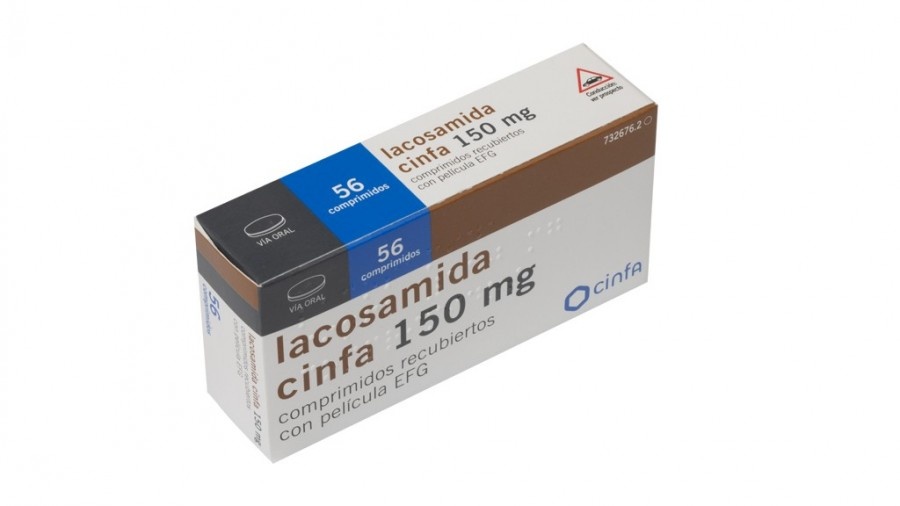

LACOSAMIDE OLPHA 150 mg FILM-COATED TABLETS

Ask a doctor about a prescription for LACOSAMIDE OLPHA 150 mg FILM-COATED TABLETS

How to use LACOSAMIDE OLPHA 150 mg FILM-COATED TABLETS
Introduction
Package Leaflet: Information for the User
Lacosamida Olpha 50 mg film-coated tablets EFG
Lacosamida Olpha 100 mg film-coated tablets EFG
Lacosamida Olpha 150 mg film-coated tablets EFG
Lacosamida Olpha 200 mg film-coated tablets EFG
Read all of this leaflet carefully before you start taking this medicine because it contains important information for you.
- Keep this leaflet, you may need to read it again.
- If you have any further questions, ask your doctor or pharmacist.
- This medicine has been prescribed for you only. Do not pass it on to others. It may harm them, even if their signs of illness are the same as yours.
- If you get any side effects, talk to your doctor or pharmacist. This includes any possible side effects not listed in this leaflet. See section 4.
Contents of the pack
- What is Lacosamida Olpha and what is it used for
- What you need to know before you take Lacosamida Olpha
- How to take Lacosamida Olpha
- Possible side effects
5 Storage of Lacosamida Olpha
- Contents of the pack and other information
1. What is Lacosamida Olpha and what is it used for
What is Lacosamida
This medicine contains lacosamida, which belongs to a group of medicines called
“antiepileptic medicines”. These medicines are used to treat epilepsy.
- You have been prescribed this medicine to reduce the number of seizures you have.
What is Lacosamida used for
- Lacosamida is used:
- on its own and with other antiepileptics in adults, adolescents, and children from 2 years of age to treat a certain type of epilepsy called “partial-onset seizures with or without secondary generalisation”. In this type of epilepsy, the seizures affect only one side of your brain. However, they can then spread to larger areas on both sides of your brain;
- with other antiepileptics in adults, adolescents, and children from 4 years of age to treat primary generalised tonic-clonic seizures (grand mal seizures, with loss of consciousness) in patients with idiopathic generalised epilepsy (a type of epilepsy that is believed to have a genetic origin).
2. What you need to know before you take Lacosamida Olpha
Do not take Lacosamida
- if you are allergic to lacosamida or any of the other ingredients of this medicine
(listed in section 6). If you are not sure, talk to your doctor.
- if you have a heart problem called second or third degree AV block.
Do not take this medicine if any of the above applies to you. If you are not sure, talk to your doctor or pharmacist before taking this medicine.
Warnings and precautions
Talk to your doctor before you start taking this medicine if:
- you have thoughts of harming yourself or suicide. A small number of people taking antiepileptics such as lacosamida have had thoughts of harming themselves or suicide. If at any time you have these thoughts, contact your doctor immediately.
- you have a heart problem that affects your heart beat and your pulse is often particularly slow, fast or irregular (such as AV block, atrial fibrillation and atrial flutter).
- you have severe heart disease such as heart failure or have had a heart attack.
- you often feel dizzy or faint. Lacosamida may cause dizziness, which could increase the risk of accidental injury or falls. This means you should be careful until you are used to the effects of this medicine.
If any of the above applies to you (or you are not sure), talk to your doctor or pharmacist before taking this medicine.
If you are taking this medicine, talk to your doctor if you experience a new type of seizure or worsening of existing seizures.
If you are taking this medicine and experience symptoms of abnormal heart beat (such as slow, fast or irregular heart beat, palpitations, shortness of breath, dizziness, fainting), contact your doctor immediately (see section 4).
Children
Lacosamida is not recommended in children under 2 years of age with epilepsy characterised by partial-onset seizures, or in children under 4 years of age with primary generalised tonic-clonic seizures. This is because it is not yet known if it is effective and safe for children of this age group.
Other medicines and lacosamida
Tell your doctor or pharmacist if you are taking, have recently taken or might take any other medicines.
In particular, tell your doctor or pharmacist if you are taking any of the following medicines that affect the heart. The reason is that lacosamida may also affect the heart.
- medicines for heart problems.
- medicines that may increase the “PR interval” in a heart test (ECG or electrocardiogram) such as epilepsy or pain medicines called carbamazepine, lamotrigine or pregabalin.
- medicines used to treat certain types of irregular heart beats or heart failure.
If any of the above applies to you (or you are not sure), talk to your doctor or pharmacist before taking this medicine.
Tell your doctor or pharmacist if you are taking any of the following medicines. The reason is that they may also increase or decrease the effect of lacosamida in your body.
- medicines for fungal infections such as fluconazole, itraconazole or ketoconazol.
- medicines for HIV such as ritonavir.
- medicines for bacterial infections such as clarithromycin or rifampicin.
- a herbal medicine used to treat mild anxiety and depression called St John’s Wort.
If any of the above applies to you (or you are not sure), talk to your doctor or pharmacist before taking lacosamida.
Taking lacosamida with alcohol
As a precaution, do not take this medicine with alcohol.
Pregnancy and breast-feeding
Women of childbearing potential should discuss the use of contraceptives with their doctor.
If you are pregnant or breast-feeding, think you may be pregnant or are planning to have a baby, ask your doctor or pharmacist for advice before taking this medicine.
Lacosamida should not be taken during pregnancy, as it is not known how it affects the unborn baby.
It is not recommended to breast-feed while taking this medicine, as it passes into breast milk. Ask your doctor for advice if you are pregnant or plan to become pregnant. They will help you decide if you should take lacosamida or not.
Do not stop treatment without talking to your doctor first, as this may increase seizures. Worsening of your condition may also harm the unborn baby.
Driving and using machines
Do not drive, ride a bike, or use any tools or machines until you know if this medicine affects you. The reason is that lacosamida may cause dizziness or blurred vision.
3. How to take/use Lacosamida Olpha
Always take this medicine exactly as your doctor or pharmacist has told you. If you are not sure, check with your doctor or pharmacist. Other forms of this medicine may be more suitable for children; ask your doctor or pharmacist.
Taking Lacosamida
- Take lacosamida twice a day, with an interval of approximately 12 hours.
- Try to take it at the same time each day.
- Take the lacosamida tablet with a glass of water.
- You can take lacosamida with or without food.
Normally, you will start with a low dose each day and your doctor will gradually increase the dose over several weeks. When you reach the dose that works best for you, called the “maintenance dose”, you will take the same amount each day. Lacosamida is used as long-term treatment. You will need to keep taking lacosamida until your doctor tells you to stop.
How much to take
The following are the usual recommended doses of lacosamida for different age and weight groups. Your doctor may prescribe a different dose if you have kidney or liver problems.
Adults, adolescents and children weighing 50 kg or more
When taking lacosamida on its own:
The usual starting dose is 50 mg twice a day.
Your doctor may also prescribe a starting dose of 100 mg of lacosamida twice a day. Your doctor may increase the dose you take twice a day by 50 mg each week, until you reach a maintenance dose between 100 mg and 300 mg twice a day.
When taking lacosamida with other antiepileptic medicines:
The usual starting dose is 50 mg twice a day.
Your doctor may increase the dose you take twice a day by 50 mg each week, until you reach a maintenance dose between 100 mg and 200 mg twice a day.
If you weigh 50 kg or more, your doctor may start treatment with a single “loading dose” of 200 mg. You would then start taking the maintenance dose 12 hours later.
Children and adolescents weighing less than 50 kg
- In the treatment of partial-onset seizures: note that this medicine is not recommended for children under 2 years of age.
- In the treatment of primary generalised tonic-clonic seizures: note that this medicine is not recommended for children under 4 years of age.
The dose depends on body weight. Treatment is usually started with the oral solution and only changed to tablets if the patient is able to take them and get the correct dose with tablets of different strengths. Your doctor will prescribe the formulation that best suits you.
If you take more Lacosamida than you should
If you have taken more lacosamida than you should, talk to your doctor immediately. Do not attempt to drive.
You may experience:
- dizziness;
- feeling sick (nausea) or being sick (vomiting);
- seizures (fits), heart beat problems such as slow, fast or irregular pulse, coma or low blood pressure with fast heart rate and sweating.
In case of overdose or accidental ingestion, contact your doctor, pharmacist or the Toxicological Information Service immediately, telephone: 91 562 04 20, stating the medicine and the amount taken.
If you forget to take Lacosamida
- If you miss a dose within 6 hours of the scheduled dose, take it as soon as you remember.
- If you miss a dose after 6 hours of the scheduled dose, do not take the missed dose. Instead, take lacosamida at the next normal time.
- Do not take a double dose to make up for forgotten doses.
If you stop taking Lacosamida
- Do not stop taking lacosamida without talking to your doctor first, as your epilepsy may come back or get worse.
- If your doctor decides to stop your treatment with lacosamida, they will tell you how to reduce the dose gradually.
If you have any further questions on the use of this medicine, ask your doctor or pharmacist.
4. Possible side effects
Like all medicines, lacosamida can cause side effects, although not everybody gets them.
Side effects on the nervous system, such as dizziness, may be greater after a single “loading dose”.
Tell your doctor or pharmacist if you get any of the following side effects:
Very common: may affect more than 1 in 10 people
- headache;
- feeling dizzy or sick (nausea);
- double vision (diplopia).
Common: may affect up to 1 in 10 people
- brief, shock-like jerks of a muscle or a group of muscles (myoclonic seizures);
- difficulty in coordinating movements or walking;
- problems with balance, shakiness (tremor), tingling (paraesthesia) or muscle spasms, falling easily and bruising;
- memory problems, difficulty in thinking or finding words, confusion;
- rapid, uncontrolled movements of the eyes (nystagmus), blurred vision;
- feeling dizzy (vertigo), feeling drunk;
- being sick (vomiting), dry mouth, constipation, indigestion, excessive gas in the stomach or intestines, diarrhoea;
- decreased sensitivity, difficulty in speaking, changes in attention;
- ringing in the ears like buzzing, ringing or whistling;
- irritability, sleep problems, depression;
- drowsiness, tiredness or weakness (asthenia);
- itching, rash.
Uncommon: may affect up to 1 in 100 people
- slow heart rate, palpitations, irregular pulse or other changes in heart activity (conduction disorder);
- feeling extremely happy, seeing and/or hearing things that are not real;
- allergic reaction to taking the medicine, hives;
- blood tests may show abnormalities in liver function tests, liver damage;
- thoughts of self-harm or suicide or attempted suicide: tell your doctor immediately;
- feeling angry or agitated;
- abnormal thoughts or loss of sense of reality;
- severe allergic reactions, which cause swelling of the face, throat, hands, feet, ankles or lower legs;
- fainting;
- abnormal, involuntary movements (dyskinesia).
Frequency not known: cannot be estimated from the available data
- abnormally fast heart rate (ventricular tachyarrhythmia);
- sore throat, high temperature and infections more often than usual. Blood tests may show a severe decrease in a specific type of white blood cell (agranulocytosis);
- severe skin reaction, which may include high temperature and other flu-like symptoms, rash on the face, generalised rash with swollen lymph nodes (lymphadenopathy). Blood tests may show increased liver enzyme levels and an increase in a type of white blood cell (eosinophilia);
- a widespread rash with blisters and skin peeling, especially around the mouth, nose, eyes and genitals (Stevens-Johnson syndrome) and a more severe form causing skin peeling in more than 30% of the body surface (toxic epidermal necrolysis):
- seizures.
Other side effects in children
Additional side effects seen in children were fever (pyrexia), runny nose (nasopharyngitis), sore throat (pharyngitis), eating less than usual (decreased appetite), changes in behaviour, not acting as they normally do (abnormal behaviour) and lack of energy (lethargy). Drowsiness (somnolence) is a very common side effect in children and may affect more than 1 in 10 children.
Reporting of side effects
If you get any side effects, talk to your doctor or pharmacist. This includes any possible side effects not listed in this leaflet. You can also report side effects directly via the Spanish Medicines Agency website: www.notificaRAM.es. By reporting side effects, you can help provide more information on the safety of this medicine.
5. Storage of Lacosamida Olpha
Keep this medicine out of the sight and reach of children.
Do not use this medicine after the expiry date which is stated on the carton and blister after EXP. The expiry date refers to the last day of the month shown.
Do not store above 30°C
Medicines should not be disposed of via wastewater or household waste. Ask your pharmacist how to dispose of medicines no longer required. These measures will help protect the environment.
6. Packaging Contents and Additional Information
Composition of Lacosamida Olpha
- The active ingredient is lacosamide.
Each Lacosamida Olpha 50 mg tablet contains 50 mg of lacosamide.
Each Lacosamida Olpha 100 mg tablet contains 100 mg of lacosamide.
Each Lacosamida Olpha 150 mg tablet contains 150 mg of lacosamide.
Each Lacosamida Olpha 200 mg tablet contains 200 mg of lacosamide.
- The other components are:
Core of the tablet: microcrystalline cellulose (101), microcrystalline cellulose (102), crospovidone type A, colloidal silicon dioxide, hydroxypropylcellulose (low substituted), hydroxypropylcellulose, magnesium stearate.
Coating:
50 mg:
hypromellose 6mPas (E464), hypromellose 15mPas (E464), titanium dioxide (E171), talc (E553b), polyvinyl alcohol (E1203), polyethylene glycol 3350 (E1521), lecithin (E322), red iron oxide (E172), black iron oxide (E172)
100 mg:
hypromellose 6mPas (E464), hypromellose 15mPas (E464), titanium dioxide (E171), talc (E553b), polyvinyl alcohol (E1203), polyethylene glycol 3350 (E1521), lecithin (E322), yellow iron oxide (E172)
150 mg:
hypromellose 6mPas (E464), hypromellose 15mPas (E464), titanium dioxide (E171), talc (E553b), polyvinyl alcohol (E1203), polyethylene glycol 3350 (E1521), lecithin (E322), red iron oxide (E172), yellow iron oxide (E172), black iron oxide (E172)
200 mg
hypromellose 6mPas (E464), hypromellose 15mPas (E464), titanium dioxide (E171)
talc (E553b), polyvinyl alcohol (E1203), polyethylene glycol 3350 (E1521)
lecithin (E322), aluminum lake indigo carmine (E132)
Appearance of the Product and Packaging Contents
- Lacosamida Olpha 50 mg are film-coated, oval, biconvex tablets, pink in color, marked with “L50” on one side and smooth on the other.
- Lacosamida Olpha 100 mg are film-coated, oval, biconvex tablets, yellow in color, marked with “L100” on one side and smooth on the other.
- Lacosamida Olpha 150 mg are film-coated, oval, biconvex tablets, salmon in color, marked with “L150” on one side and smooth on the other.
- Lacosamida Olpha 200 mg are film-coated, oval, biconvex tablets, blue in color, marked with “L200” on one side and smooth on the other.
Lacosamida Olpha is available in packs of 14, 28, 56, 98, and 168 film-coated tablets, in aluminum blister packs.
Only some pack sizes may be marketed.
Marketing Authorization Holder and Manufacturer
Marketing Authorization Holder
Olpha AS,
Rupnicu iela 5,
Olaine, Olaines novads, LV-2114,
Latvia
Manufacturer
Macleods Pharma UK Limited.
Wynyard Park House,
Wynyard Avenue,
Wynyard, Billingham,
TS22 5TB,
United Kingdom
Synoptis Industrial Sp. z o.o
ul. Rabowicka 15, 62-020
Swarzedz, Poland
Date of the Last Revision of thisLeaflet:
Detailed information on this medicinal product is available on the website of the Spanish Agency for Medicines and Health Products (AEMPS) (http://www.aemps.gob.es/)

How much does LACOSAMIDE OLPHA 150 mg FILM-COATED TABLETS cost in Spain ( 2026)?
The average price of LACOSAMIDE OLPHA 150 mg FILM-COATED TABLETS in January, 2026 is around 98.68 EUR. Prices may vary depending on the region, pharmacy, and whether a prescription is required. Always check with a local pharmacy or online source for the most accurate information.
- Country of registration
- Average pharmacy price98.68 EUR
- Active substance
- Prescription requiredYes
- Manufacturer
- This information is for reference only and does not constitute medical advice. Always consult a licensed doctor before taking any medication. Oladoctor is not responsible for medical decisions based on this content.
- Alternatives to LACOSAMIDE OLPHA 150 mg FILM-COATED TABLETSDosage form: TABLET, 100 mgActive substance: lacosamideManufacturer: Intas Third Party Sales 2005 S.L.Prescription requiredDosage form: TABLET, 150 mgActive substance: lacosamideManufacturer: Intas Third Party Sales 2005 S.L.Prescription requiredDosage form: TABLET, 200 mgActive substance: lacosamideManufacturer: Intas Third Party Sales 2005 S.L.Prescription required
Alternatives to LACOSAMIDE OLPHA 150 mg FILM-COATED TABLETS in other countries
The best alternatives with the same active ingredient and therapeutic effect.
Alternative to LACOSAMIDE OLPHA 150 mg FILM-COATED TABLETS in Poland
Alternative to LACOSAMIDE OLPHA 150 mg FILM-COATED TABLETS in Ukraine
Online doctors for LACOSAMIDE OLPHA 150 mg FILM-COATED TABLETS
Discuss dosage, side effects, interactions, contraindications, and prescription renewal for LACOSAMIDE OLPHA 150 mg FILM-COATED TABLETS – subject to medical assessment and local rules.







